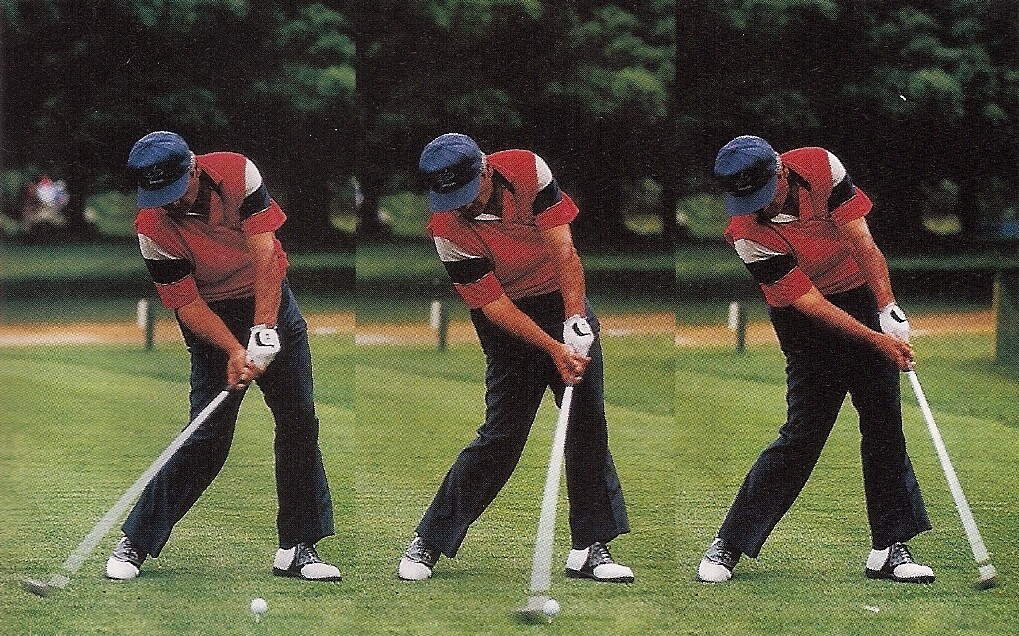Here’s a Trackman newsletter from July 2009 that explains quite a bit of things. (trackman.dk/getmedia/2f6c5cdc-e1 … 009_1.aspx)
Some definitions that need to be cleared up when it comes to Trackman:
Horizontal swing plane = Also known as the ‘plane line.’ In ABS terms, the release. Do you release ‘left’ (Hogan) or do you release out to the ‘right?’ (Clampett)
Vertical Swing Plane = the inclined plane the golfer swings on the downswing. Elbow plane is at a much flatter angle than the turned shoulder plane. This would be measured from the DTL view.
Attack Angle = Angle that the clubhead comes into the the ball. Measured from the face on view. Tour averages are -5* with a PW, -4* with a 7-iron, -3* with a 3-iron and -1* with a driver.
Clubhead Path = The path of the clubhead just BEFORE impact and then at impact.
In order to hit it DEAD straight, we need a clubface angle at impact of about 0* to the target. We also need a clubhead path of about 0* to the target. But the only way we can achieve that 0* clubhead PATH is to have our ‘release’ in proper conjunction with the attack angle (and to an extent the vertical swing plane).
For the sake of BREVITY, the GENERAL rule of thumb is that if you have a square face and if you have a sweetspot strike, we need to release the clubhead 1/2 of the attack angle with an iron (this is for golfers with a 60* vertical swing plane, but again it’s a general rule of thumb for the sake of brevity).
So if our attack angle is -4* with a 6-iron, then in order to hit it straight we need to release left by 2*. If it was a -10* attack angle, then it would be a -5* release to the left. If you follow that ‘release to attack angle formula’ that will actually create a club path (the direction the clubhead is coming into the ball BEFORE IMPACT) of 0*.
I believe that Trackman validates Lag’s claims quite clearly. Lag used to have a ‘release out to the right swinging procedure.’ Not only did that cause problems with him controlling the clubface, but if he executed like he was supposed to, it would make it almost impossible to hit it dead straight because the clubhead path would be dead straight. He could be really good hitting a draw with that procedure, but tough to do with consistency if you can’t control the clubface that well.
Remember Lag has said that hitting balls is good for coordination, but his drills are good for retraining muscles and the pivot. That’s why he used to hit so many golf balls back in the day. Not only did he have a swing where the hands controlled the clubface, but the path out was out to the right anyway, so even if he was really controlling the clubface on a certain day, he was likely to see some sizeable curvature of his ball flight. But if his hands were not controlling the face that well on that day, even if they were just slightly off, then he would see some very wayward shots.
What Lag has done IMO, is he completely improved his clubface control and his path when he started creating a pivot driven, hold the flex past impact, release left type of swing. That’s a great thing. I hope to accomplish it as well. I am quite certain that if Lag went onto a Trackman, his numbers would be top notch.
I’m certain that if Trevino went onto a Trackman and you told him to hit one dead straight, he could and his numbers would show he was releasing left. Why? Because that’s what he has to do according to the laws of physics.
Moe OTOH has a much shallower attack angle (bacon strips, not pork chops) and it’s no coincidence to me that he released further out to the right. Clampett took sizeable divots and release out to the right. And it’s no coincidence IMO that he struggled with the hook.
Trackman validates what good/great players knew, either consciously or subconsciously, long ago.
3JACK

